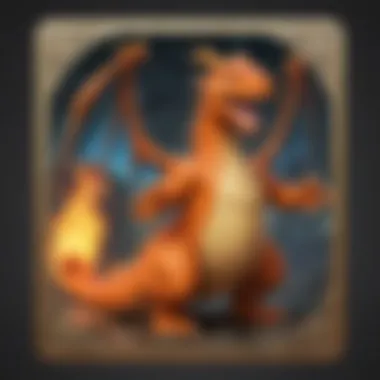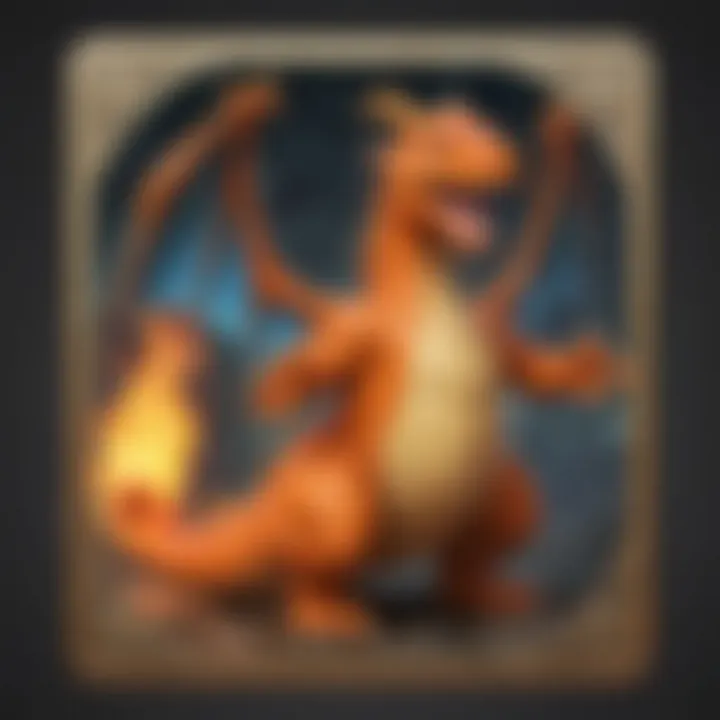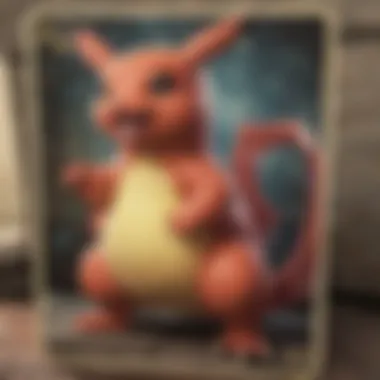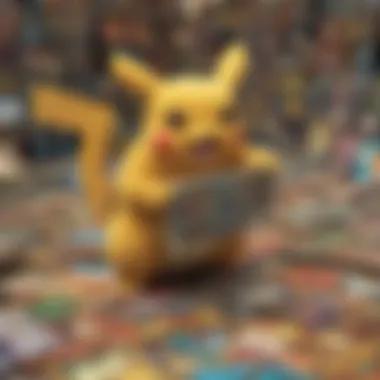The Current Value of Pokémon Cards: An In-Depth Analysis


Intro
The contemporary market for Pokémon cards is a complex landscape shaped by numerous factors. The values attributed to these collectibles fluctuate based on rarity, condition, and market trends. This analysis seeks to deepen your understanding of the current financial state of Pokémon card trading. Collectors and enthusiasts will find insights that can inform both their collecting strategies and investment decisions.
Pokemon Game Overview
History of Pokemon Games
Pokémon, originally a video game franchise that began in 1996, has expanded beyond games into various media, including an animated series and trading cards. The initial release of Pokémon Red and Blue laid the foundation for a series that would rapidly gain immense popularity worldwide. The franchises’ mixture of adventure, strategy, and social interaction has kept its fan base engaged for decades.
Evolution of Gameplay Mechanics
Throughout the years, Pokémon has seen numerous gameplay updates and mechanics enhancements. The introduction of features like Pokémon breeding, abilities, and online battles added layers of depth to the games. Each new generation brings fresh Pokémon and innovative game mechanics that continually attract both new and veteran players alike. The consistent evolution ensures that the gameplay remains relevant and captivating.
Preface to Different Game Versions
Various Pokémon games have been released, from main series titles like Pokémon Sword and Shield to spin-offs like Pokémon Go. Each version offers unique experiences and caters to different types of players. The accessibility of mobile games, for instance, expanded the audience far beyond traditional gamers. This variety propels ongoing interest in Pokémon gameplay and indirectly affects the trading card market.
Value Assessment of Pokémon Cards
In assessing Pokémon card value, three key elements emerge: rarity, condition, and demand. Rarity refers to how many cards exist in circulation, while condition reflects wear and tear. Demand correlates with the current interest in specific cards or sets – often fueled by nostalgia or cultural phenomena.
Important Note: Market trends can change rapidly based on public interest, celebrity endorsements, or media portrayals. It is vital for collectors to stay updated on these variables.
Rarity
The scarcity of a card significantly impacts its value. Cards printed in limited editions, such as the Pikachu Illustrator or certain promotional cards, often command high prices. Notably, first edition cards also hold a premium because they represent some of the franchise's earliest offerings.
Condition
The physical condition of cards plays a crucial role in determining their market price. Cards graded by professional services like PSA or Beckett often fetch higher prices than ungraded cards. Factors like scratches, bends, or discoloration diminish a card’s worth, making condition a critical aspect for collectors to monitor.
Demand
Demand in the Pokémon card market is often unpredictable. Specific cards may gain popularity due to social media trends or tournament results. Collectors can capitalize on these trends, but they also risk losing value if demand shifts.
Tips and Strategies
To navigate the Pokémon card market successfully, consider the following:
- Research Thoroughly: Understanding specific cards and their historical prices can provide you with a good baseline.
- Educate Yourself on Grading: Knowing how to evaluate conditions can help you make informed buying decisions.
- Network with Fellow Collectors: Engaging in discussions on platforms such as reddit.com can provide insights and opportunities.
Maintaining an awareness of market trends is essential for anyone involved in card trading. Always approach buying and selling with a strategic mindset to maximize potential gains.
End
The value of Pokémon cards transcends mere numbers; it encapsulates shared experiences, nostalgia, and personal journeys for collectors. By understanding the factors that influence card values, enthusiasts can better navigate the market landscape. Education and proactive engagement are key to making informed decisions in this vibrant arena.
Prolusion to the Pokémon Card Market
The Pokémon card market has emerged as a significant area of interest for collectors and investors alike. Understanding this market is crucial, as it shapes the financial landscape for cards that many grew up with. The importance lies not only in knowing their current values but also in comprehending the factors that influence these values. This first section acts as a primer, giving readers insight into the background and evolution of Pokémon cards.
Historical Overview of Pokémon Cards
The origin of Pokémon cards dates back to 1996 when the Pokémon Company launched the trading card game alongside the video game series. Initially, the cards targeted children and served as a way to build community among players. As popularity grew, so did the production and variety of cards. Early editions, like the Base Set, became collectibles almost overnight. The distribution strategies used at the time also played a role in establishing the market's foundation.
As the years passed, Pokémon cards evolved in design and gameplay mechanics. Expansion sets were regularly released, each introducing new mechanics and Pokémon, further deepening the enthusiast's experience. Over time, these cards developed more than just gameplay value; they became symbols of nostalgia, community, and connection.


Rise in Popularity and Impact on Prices
In the last decade, Pokémon cards have seen a massive resurgence in interest, resulting in significant impacts on their market prices. Factors such as online sales platforms and social media have contributed to this revival. Many influencers and content creators showcase nostalgic and rare cards, thereby raising awareness and desire among younger audiences. This surge has led to dramatic price increases for specific cards, particularly those from the original sets.
Additionally, the global pandemic also impacted the card market. With more people staying at home, interest in collectible trading surged. Fluctuations in pricing emerged as high-profile auction sales garnered media attention. Top cards, such as the Pikachu Illustrator card, have fetched sums in the hundreds of thousands, illustrating not only the strong demand but also the potential for significant financial investment.
This growth presents both opportunities and challenges for collectors and investors. Understanding historical context is vital to navigating the current landscape. By recognizing the factors that led to price increases and the communities built around card collecting, one can approach buying, selling, and valuing Pokémon cards with greater insight.
Factors Influencing Pokémon Card Values
Understanding the factors that influence Pokémon card values is essential for any collector or investor. As the market evolves, these factors become even more significant in determining the worth of individual cards. This section will address the key elements that shape the landscape of Pokémon card values, analyzing how rarity, condition, and market demand impact pricing.
Rarity and Scarcity
Rarity is a fundamental element in the valuation of Pokémon cards. Cards produced in limited quantities tend to be more sought after by collectors. For instance, promotional cards released during special events, such as the Trophy Pikachu, are known for their extreme scarcity and often command high prices in auctions.
Scarcity can be categorized in several ways:
- Print Run: Limited print runs contribute to higher demand.
- Error Cards: Cards with printing errors can fetch higher prices due to their uniqueness.
- Retired Sets: Sets that are no longer produced naturally become rarer over time.
The interplay between rarity and market interest directly influences prices. When a rare card enters the market, collectors will often compete, driving its value upward. This highlights the significance of keeping track of market trends and developments to take advantage of potential investments.
Condition and Grading Considerations
The condition of Pokémon cards is another pivotal factor in determining their value. A card's state can vary significantly, affecting potential resale prices. The grading system, primarily managed by third-party services such as PSA (Professional Sports Authenticator) and Beckett Grading Services, offers a means to evaluate cards on a standardized scale.
- Mint Condition: Cards that have never been played or handled improperly can receive a high grade.
- Near Mint Condition: Slight imperfections may be present but do not significantly detract from the card's visual appeal or integrity.
- Lower Grades: Cards with scratches, bends, or other damage can reduce a card's value dramatically.
For collectors, understanding grades is essential. Higher-graded cards usually generate significant interest within the community. Consequently, maintaining cards in optimal condition, whether through storage methods or handling precautions, becomes crucial for anyone serious about their collection.
Market Demand and Pop Culture Influence
Market demand is driven by several influences, one of which is pop culture. Pokémon cards have seen varying levels of interest due to trends within the wider entertainment realm. New releases, anime series, or nostalgic factors can boost interest dramatically. For instance, The Pokémon Company's continued efforts in expanding their franchise—films, games, or merchandise—keep the interest level high.
Social media also plays a role, as platforms like Reddit and Facebook facilitate community discussions around trading, collecting, and selling. The enthusiasm for certain cards can lead to a surge in prices based on perceived value created through social influence.
To summarize, the factors influencing Pokémon card values intertwine to create a complex market landscape. Rarity dictates initial pricing, while condition and demand further refine these values. Keeping a finger on the pulse of trends and communities enables collectors and investors to make informed decisions.
Current Market Trends
Market trends are vital for understanding the evolving landscape of Pokémon card values. The dynamics within the market are influenced by various factors that can shift rapidly. As more collectors enter the scene and nostalgic fans revisit their childhood interests, the demand for specific cards continues to fluctuate. Recognizing these trends can be beneficial for both buyers and sellers. Moreover, knowing the current state of the market helps enthusiasts make informed decisions regarding acquisitions and sales.
Recent Sales Data and Price Trends
Analyzing recent sales data is crucial in gauging the current market for Pokémon cards. Over the past few years, there has been a noticeable increase in sales volume and prices, particularly for vintage and rare cards. Websites like eBay and auction platforms have provided valuable insights into what collectors are willing to pay.
Card prices can vary widely based on several variables, including rarity, condition, and popularity. For instance, high-profile sales include iconic cards such as the first edition Charizard. This particular card has sold for tens of thousands of dollars, highlighting how desirable it is among collectors. In contrast, more common cards see lower price points, often only a few dollars.
Key trends observed in sales data include:
- Increased Demand: Cards from early sets like Base Set and Jungle see significant interest.
- Record Sales: Recently, several auctions have resulted in unprecedented sales figures, driving attention to the market.
- Price Volatility: Fluctuations can occur based on market sentiment and news related to Pokémon events or releases.
"The Pokémon card market is not just about nostalgia; it has become a serious investment avenue for many collectors."
Popular Card Sets and Their Values
Certain card sets hold more value than others due to various factors. Understanding which sets are currently favored can guide collectors in making strategic decisions. The value of popular card sets tends to fluctuate based on demand and their cultural relevance at any given moment.
Notable Card Sets Include:


- Base Set: The original collection remains a crown jewel for collectors. Cards like Charizard and Blastoise are particularly sought after, often fetching high prices.
- Neo Genesis: This set introduced many fan-favorite Pokémon, and certain cards, particularly those featuring Shining variants, can be quite valuable.
- Hidden Fates: A more recent set that has gained immense popularity, especially for its shiny versions of well-known Pokémon.
Current values can vary significantly. Card prices from these sets can range from under a dollar for common cards to thousands for graded, rare finds. Instruction on how to assess the condition of cards plays a substantial role in determining their market price.
Valuing Your Pokémon Cards
Understanding the value of Pokémon cards is crucial for collectors and enthusiasts alike. Accurate valuation influences buying, selling, and trading strategies within the market. Several factors contribute to a card's worth, including rarity, condition, and demand. This section aims to provide insightful guidance on how to effectively value your Pokémon cards.
Assessing Card Condition
The condition of a Pokémon card significantly impacts its market value. Cards range from mint condition to heavily played, and each grade carries a different price point.
To assess the condition, collectors should consider several aspects:
- Surface: Look for scratches, dents, or wear.
- Corners: Sharp corners indicate a better condition compared to rounded or damaged ones.
- Edges: Tattered edges can lower value significantly.
- Centering: A well-centered card is more desirable.
Evaluating these elements carefully is essential. Many collectors rely on grading systems from professional services, such as PSA or CGC, to determine a card's condition. A high-grade card from these services can command much higher prices.
Using Online Resources for Valuation
In today's digital age, numerous resources exist for valuing Pokémon cards. Online platforms can provide essential price data and trends. Here are some effective tools and websites:
- Price Guide Websites: Websites like TCGPlayer offer price averages based on recent sales, helping establish a baseline for your card's value.
- Auction Results: Observing auction sites, such as eBay, reveals what buyers are willing to pay at any given moment.
- Collector Forums: Communities on Reddit and Facebook provide insights and personal experiences regarding card valuations.
Utilizing these resources can lead to informed selling or purchasing decisions. Collectors can sign up for alerts on specific cards or follow trends in certain sets to stay updated.
Remember, market values can fluctuate based on demand and trends, so regular assessments are beneficial.
Being knowledgeable about assessing card condition and leveraging online tools is key to mastering the art of valuing Pokémon cards. This understanding not only enhances the collecting experience but also maximizes potential investments.
Buying and Selling Strategies
The world of Pokémon cards is not merely a hobby; it is an intricate marketplace that requires understanding of various strategies to maximize buying and selling potential. The importance of developing effective buying and selling strategies cannot be overstated. Various factors, such as timing and knowledge of market trends, play crucial roles in determining success. Such strategies can enhance value retention and provide lucrative returns.
When entering the market, both collectors and investors must be pragmatic. They must recognize that each card has its own unique value. Therefore, knowing when to buy and sell cards is essential for making informed decisions. One obvious benefit is avoiding common pitfalls that can lead to financial losses. Knowing key elements of the buying process helps one identify undervalued cards, while effective selling techniques can maximize profit margins.
Where to Buy Pokémon Cards
When seeking to buy Pokémon cards, options are abundant but caution is critical. Some of the most popular avenues include:
- Local Game Shops: Often have a selection of new and used cards. Establishing a rapport with store owners can yield valuable insights into upcoming sales or events.
- Online Marketplaces: Websites such as eBay host auctions and direct sales. It's vital to review seller ratings and descriptions to ensure quality.
- Card Shows and Conventions: These events provide opportunities to purchase cards directly from other collectors. Additionally, they allow for face-to-face negotiation which can lead to better deals.
- Social Media Platforms: Communities on Reddit and Facebook often sell cards directly or trade them, creating a dynamic exchange environment.
Furthermore, using price guides and online valuation tools can assist in evaluating whether a card's price is reasonable or inflated.
Effective Selling Techniques
Selling Pokémon cards effectively requires a strategy that is both succinct and appealing. Here are some important techniques:
- Research Pricing: Before listing any card, consult recent sales data to set competitive prices. Websites like TCGPlayer provide excellent benchmarks.
- High-Quality Images: Listing cards with clear, high-resolution images allows buyers to see condition and authenticity. Allowing for zoom functionalities can further improve buyer confidence.
- Detailed Descriptions: Be transparent about the condition and history of the card. Listing factors such as grading or any imperfections builds trust among potential buyers.
- Engaging with the Community: Participating in Pokémon forums and social media groups can increase visibility of what you are selling. Networking often leads to more potential customers.
- Timing the Sale: Keeping an eye on market trends can dictate when to sell for the best price. Seasonal trends can also affect prices when certain cards gain popularity around events or promotions.
"Timing is crucial in both buying and selling Pokémon cards. Understanding market cycles can lead to better financial outcomes."
In summary, mastering buying and selling strategies in the Pokémon card market is critical. It involves a combination of knowledge, research, and understanding market dynamics. Through careful practices, collectors and investors can navigate potential risks while enhancing their card collections or profits.
Investment Potential of Pokémon Cards
The world of Pokémon cards has evolved into a sophisticated market that extends beyond mere nostalgia. The segment focused on investment potential is essential for understanding how these cards can function as assets in financial terms. Many collectors nowadays seek not just enjoyment but also profit from their hobby. Recognizing the potential value of Pokémon cards can reshape the motivations of collectors, leading them to treat this passion with a more strategic mindset.
This section examines some critical aspects of why investing in Pokémon cards is considered a viable option. Moreover, it addresses the different benefits derived from this investment, including financial returns and personal satisfaction. It is also essential to highlight the considerations that individuals should keep in mind before diving into the commercial landscape of Pokémon cards.


Understanding Pokémon Cards as an Asset
The standpoint of viewing Pokémon cards as a financial asset offers some advantages. First, it places value on rarity and demand, two primary factors that can drive high prices in the market. Many cards have seen their values increase significantly over the years. Some of the rarest cards, such as the Pikachu Illustrator card, has been sold for staggering amounts.
Moreover, the collectibles market often proves more resilient compared to traditional assets like stocks or bonds during economic downturns. This is partly because unique collectibles can maintain their value even when conventional financial instruments experience volatility. Investing in Pokémon cards can provide a hedge against inflation, offering collectors comfort during uncertain financial times.
The appeal of Pokémon cards also lies in the trend toward nostalgia and pop culture revival. As generations grow up, the appreciation for childhood items can radically increase, thus making them valuable as both collectibles and investment assets. Collectors may find value not only in the cards themselves but in the memories attached to them.
Risks and Considerations in Investment
While investing in Pokémon cards presents numerous benefits, it is crucial to be aware of associated risks and considerations. The market is volatile, influenced by trends, demand, and external factors that can shift abruptly. Pricing sometimes hinges on the whims of collectors, making it unpredictable over time.
Additionally, proper research is paramount to successful investment. One must be informed about which cards are trending in value and which have potential for growth.
Here are some key points to keep in mind when considering Pokémon card investment:
- Market Knowledge: Understand current trends by reading market analyses and researching recent sales.
- Grading Matters: Card condition significantly impacts value. Invest in cards that are well-maintained or graded by professional organizations, such as PSA or Beckett.
- Speculation Risks: Be cautious of investing in high-profile cards that may see inflated prices due to speculation. Sometimes, the bubble may burst, leading to significant losses.
- Long-term vs. Short-term: Determine your investment strategy. Many collectors see more success focusing on long-term, stable investments rather than quick flips.
"Investing in Pokémon cards is not just about purchasing; it's about understanding the market dynamics that govern value."
The Role of Auctions in the Market
Auctions play a crucial role in the market for Pokémon cards, serving not just as venues for buying and selling, but also as intelligent indicators of market value. They provide a transparent setting where collectors can gauge the worth of specific cards against real-time bids. This dynamic marketplace can influence buyers' perceptions, making it essential to understand how auctions operate and what impact they can have on prices.
One important consideration is that auctions often drive prices higher for rare and sought-after cards. When multiple collectors desire the same item, competitive bidding ensues, which can lead to price surges. Moreover, auction results can create benchmarks, lending insight into the fluctuating market of cards based on popular demand, condition, and rarity among other factors.
A consistent influx of well-organized auctions has also fostered community engagement, drawing in Pokémon enthusiasts from various backgrounds. It's not only an opportunity to complete a collection but also a chance to connect with like-minded individuals. Collectors should be aware, however, that auction prices can also reflect irrational exuberance at times, making it critical to approach with knowledge.
How Auctions Affect Prices
Prices of Pokémon cards in auctions can be influenced by numerous factors. First, the unique nature of auctions means that scarcity often plays a large role. A card that is limited in distribution or exceptionally rare will attract higher interest and bids, significantly affecting its final sale price. For example, a high-grade Charizard card can command hundreds of thousands during auctions due to its coveted status.
Second, the displayed condition of the card is particularly vital. Grading agencies like PSA, BGS, and CGC assess card condition, and a well-graded card typically fetches a better price. At auctions, items with higher grades are often the focal point, underscoring the importance of proper card care and grading before selling.
Also, the timing of the auction matters. A sudden break in Pokémon news, like a new game release or anniversary, can increase interest in Pokémon memorabilia, driving up auction prices. Conversely, an oversaturated market can lead to lower prices, emphasizing the need for collectors to be aware of current trends.
"Understanding auction behavior is key to making informed purchases and sales in the Pokémon card market."
Participating in Pokémon Card Auctions
Participating in Pokémon card auctions requires careful preparation. First, it is necessary to research upcoming auction events. Major auction houses like Heritage Auctions and Goldin Auctions frequently handle rare card sales. Additionally, online platforms like eBay and whatnot offer users another venue for auction participation.
Before entering an auction, collectors should set a budget. This budget should take into account the maximum amount willing to be spent, as competitive bidding can lead to unplanned expenses. It's wise to remain disciplined; emotional bidding often results in overpaying.
Further, another aspect of participation is understanding the bidding process itself. Familiarize with the auction’s rules regarding proxies, shill bidding, and minimum bids. Knowing these details can help streamline strategies while minimizing the risk of potential pitfalls.
Lastly, being part of an auction should also mean connecting with other collectors. Engaging with fellow fans can lead to valuable insights and keeping abreast of the market pulse. Building a network can greatly enhance the experience and increase your knowledge during auctions.
Ending
The conclusion of an article serves as a crucial element that encapsulates the insights gained throughout the discussion on the value of Pokémon cards. It synthesizes the findings while providing readers with a sense of closure and clarity regarding the ongoing evolution of the market.
Future Outlook of the Pokémon Card Market
The future of the Pokémon card market looks promising, yet it is influenced by several dynamics. With a new generation of collectors emerging, interest levels remain high. Nostalgia plays a significant role as older collectors pass their love of the franchise onto younger fans. Digital trading platforms and social media amplify community engagement, making it easier to share, trade, and discuss cards.
Current trends suggest potential for growth, especially in the high-end segment of the market. Rare cards, especially those in mint condition, continue to draw significant attention. Collectors should remain aware of ongoing releases and collaborations within the Pokémon franchise, as these often drive demand and can affect prices.
Investors considering this market need to keep an eye on macroeconomic factors as well. Economic fluctuations can influence discretionary spending on collectibles. Therefore, understanding the broader economic landscape will be essential in making informed investment decisions.
Final Thoughts for Collectors
For collectors, being informed is key. Understanding the nuances of card values, grading systems, and market trends can significantly impact purchasing and selling decisions. Engaging with communities on platforms such as Reddit and Facebook can enhance knowledge and provide insights into current market movements.
Moreover, remember to assess the condition of cards through reputable grading services. High-quality cards typically yield better returns, but each collector's experience is unique. Passion for the collection should always be at the forefront, as this hobby thrives on community and interest. Balancing emotions with informed decisions will yield a more rewarding experience in the long run.







